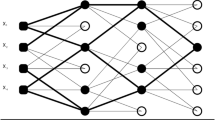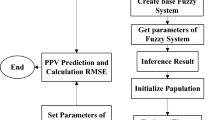Abstract
Blasting is considered as the most common technique for rock breakage in surface mines, tunneling and large infrastructural development projects. Ground vibration, as one of the most adverse effects induced by blasting operations, can cause substantial damage to structures in the nearby environment. Therefore, there is a need to make accurate predictions of blast-induced ground vibration for minimizing the environmental effects. The present paper explores the possibility of using the genetic algorithm (GA) to create a new predictive model for estimating blast-induced ground vibration at Bakhtiari dam region, Iran. In this regard, two form of equations, i.e., power and linear forms, were developed by GA. Maximum charge weight per delay (W) and distance between monitoring station and blasting point (D), as the most influential parameters on the ground vibration, were used as the input or independent variables for modeling. Also, the peak particle velocity (PPV) parameter, as a descriptor for evaluating blast-induced ground vibration, was considered as the output or dependent variables for modeling. In total, 85 blasting events were considered and the D, W and PPV parameters were precisely measured. The selected GA forms were then compared with the several empirical prediction models. Finally, it was found that the GA power form (with root-mean-square error (RMSE) 0.45 and coefficient of multiple determination (R 2) of 0.92) was more acceptable model for predicting PPV than the GA linear form and the empirical prediction models.











Similar content being viewed by others
References
Singh TN, Dontha LK, Bhardwaj V (2008) Study into blast vibration and frequency using ANFIS and MVRA. Min Technol 117(3):116–121
Verma AK, Singh TN (2013) Comparative study of cognitive systems for ground vibration measurements. Neural Comput Appl 22:341–350
Taheri K, Hasanipanah M, Bagheri Golzar S, Abd Majid MZ (2016) A hybrid artificial bee colony algorithm-artificial neural network for forecasting the blast-produced ground vibration. Eng Comput. doi:10.1007/s00366-016-0497-3
Trivedi R, Singh TN, Raina AK (2014) Prediction of blast induced flyrock in Indian limestone mines using neural networks. J Rock Mech Geotech Eng 6:447–454
Hasanipanah M, Monjezi M, Shahnazar A, Jahed Armaghani D, Farazmand A (2015) Feasibility of indirect determination of blast induced ground vibration based on support vector machine. Measurement 75:289–297
Trivedi R, Singh TN, Gupta NI (2015) Prediction of blastinduced flyrock in opencast mines using ANN and ANFIS. Geotech Geol Eng 33:875–891
Hasanipanah M, Jahed Armaghani D, Bakhshandeh Amnieh H, Abd Majid MZ, MD Tahir M (2016) Application of PSO to develop a powerful equation for prediction of flyrock due to blasting. Neural Comput Appl. doi:10.1007/s00521-016-2434-1
Hasanipanah M, Jahed Armaghani D, Monjezi M, Shams S (2016) Risk assessment and prediction of rock fragmentation produced by blasting operation: a rock engineering system. Environ. Earth Sci 75:808. doi:10.1007/s12665-016-5503-y
Hasanipanah M, Shahnazar A, Bakhshandeh Amnieh H, Jahed Armaghani D (2016) Prediction of air-overpressure caused by mine blasting using a new hybrid PSO–SVR model. Eng Comput. doi:10.1007/s00366-016-0453-2
Hasanipanah M, Shirani Faradonbeh R, Jahed Armaghani D, Bakhshandeh Amnieh H, Khandelwal M (2017) Development of a precise model for prediction of blast-induced flyrock using regression tree technique. Environ. Earth Sci 76:27. doi:10.1007/s12665-016-6335-5
Singh TN, Singh A, Singh CS (1994) Prediction of ground vibration induced by blasting. Indian Min Eng J 31–34:16
Khandelwal M, Singh TN (2007) Evaluation of blast-induced ground vibration predictors. Soil Dyn Earthq Eng 27:116–125
Khandelwal M, Singh TN (2009) Prediction of blast-induced ground vibration using artificial neural network. Int J Rock Mech Min Sci 46:1214–1222
Ghasemi E, Ataei M, Hashemolhosseini H (2012) Development of a fuzzy model for predicting ground vibration caused by rock blasting in surface mining. J Vib Control 19:755–770
Bhandari S (1997) Engineering rock blasting operations. A.A. Balkema, Netherlands
Hustrulid W (1999) Blasting principles for open pit mining: general design concepts. Balkema, Rotterdam
Mohamadnejad M, Gholami R, Ataei M (2012) Comparison of intelligence science techniques and empirical methods for prediction of blasting vibrations. Tunn Undergr Space Technol 28:238–244
Saadat M, Khandelwal M, Monjezi M (2014) An ANN-based approach to predict blast-induced ground vibration of Gol-EGohar iron ore mine, Iran. J Rock Mech Geotech Eng 6:67–76
Mohamed MT (2011) Performance of fuzzy logic and artificial neural network in prediction of ground and air vibrations. Int J Rock Mech Min Sci 48(5):845–851
Jahed Armaghani D, Hasanipanah M, Bakhshandeh Amnieh H, Mohamad ET (2016) Feasibility of ICA in approximating ground vibration resulting from mine blasting. Neural Comput Appl. doi:10.1007/s00521-016-2577-0
Hasanipanah M, Shirani Faradonbeh R, Bakhshandeh Amnieh H, Jahed Armaghani D, Monjezi M (2016) Forecasting blast-induced ground vibration developing a CART model. Eng Comput. doi:10.1007/s00366-016-0475-9
Amiri M, Bakhshandeh Amnieh H, Hasanipanah M, Mohammad Khanli L (2016) A new combination of artificial neural network and K-nearest neighbors models to predict blast-induced ground vibration and air-overpressure. Eng Comput 32:631–644. doi:10.1007/s00366-016-0442-5
Davies B, Farmer IW, Attewell PB (1964) Ground vibrations from shallow sub-surface blasts. Engineer 217:553–559
Ambraseys NR, Hendron AJ (1968) Dynamic behavior of rock masses: rock mechanics in engineering practices. Wiley, London
Bureau of Indian Standard (1973) Criteria for safety and design of structures subjected to underground blast. ISI Bulletin, IS–6922
Dowding CH (1985) Blast vibration monitoring and control. Prentice-Hall, Englewoods Cliffs, pp 288–290
ISRM (1992) Suggested method for blast vibration monitoring. Int J Rock Mech Min Geomech Abstr 29:145–156
Duvall WI, Fogleson DE (1962) Review of criteria for estimating damage to residences from blasting vibration. USBM-RI, 5968
Langefors U, Kihlstrom B (1963) The modern technique of rock blasting. Wiley, New York
Roy PP (1993) Putting ground vibration predictors into practice. J Colliery Guard 241:63–67
Rai R, Singh TN (2004) A new predictor for ground vibration prediction and its comparison with other predictors. Indian J Eng Mater Sci 11:178–184
Lapčević R, Kostić S, Pantović R, Vasović N (2014) Prediction of blast-induced ground motion in a copper mine. Int J Rock Mech Min Sci 69:19–25
Singh TN, Singh V (2005) An intelligent approach to prediction and control ground vibration in mines. Geotech Geolog Eng 23:249–262
Monjezi M, Hasanipanah M, Khandelwal M (2013) Evaluation and prediction of blast-induced ground vibration at Shur River Dam, Iran, by artificial neural network. Neural Comput Appl 22:1637–1643
Dindarloo SR (2015) Peak particle velocity prediction using support vector machines: a surface blasting case study. J South Afr Inst Min Metall 115:637–643
Verma AK, Singh TN, Chauhan NK, Sarkar K (2016) A hybrid FEM–ANN approach for slope instability prediction. J Inst Eng (India): Ser A 97(3):171–180
Hasanipanah M, Jahed Armaghani D, Khamesi H, Bakhshandeh Amnieh H, Ghoraba S (2015) Several non-linear models in estimating air-overpressure resulting from mine blasting. Eng Comput. doi:10.1007/s00366-015-0425-y
Dindarloo SR, Siami-Irdemoosa E (2015) Estimating the unconfined compressive strength of carbonate rocks using gene expression programming. Eur J Sci Res 135(3):309–316
Madhubabu N, Singh PK, Kainthola A, Mahanta B, Tripathy A, Singh TN (2016) Prediction of compressive strength and elastic modulus of carbonate rocks. Measurement 88:202–213
Singh PK, Tripathy A, Kainthola A, Bankim Mahanta, Singh V, Singh TN (2017) Indirect estimation of compressive and shear strength from simple index tests. Eng Comput 33:1–11.
Hasanipanah M, Bakhshandeh Amnieh H, Arab H, Zamzam MS (2016) Feasibility of PSO–ANFIS model to estimate rock fragmentation produced by mine blasting. Neural Comput Appl. doi:10.1007/s00521-016-2746-1
Fouladgar N, Hasanipanah M, Bakhshandeh Amnieh H (2016) Application of cuckoo search algorithm to estimate peak particle velocity in mine blasting. Eng Comput. doi:10.1007/s00366-016-0463-0
Singh R, Umrao RK, Ahmad M, Ansari MK, Sharma LK, Singh TN (2017) Prediction of geomechanical parameters using soft computing and multiple regression approach. Measurement 99:108–119
Jahed Armaghani D, Momeni E, Abad SVANK, Khandelwal M (2015) Feasibility of ANFIS model for prediction of ground vibrations resulting from quarry blasting. Environ Earth Sci. doi:10.1007/s12665-015-4305-y
Holland J (1975) Adaptation in natural and artificial systems. The University of Michigan Press, Ann Arbor
Momeni E, Nazir R, Jahed Armaghani D, Maizir H (2014) Prediction of pile bearing capacity using a hybrid genetic algorithm-based ANN. Measurement 57:122–131
Shirani Faradonbeh R, Monjezi M, Jahed Armaghani D (2015) Genetic programing and non-linear multiple regression techniques to predict backbreak in blasting operation. Eng Comput. doi:10.1007/s00366-015-0404-3.
Chipperfield A, Fleming P, Pohlheim H et al (2006) Genetic algorithm toolbox for use with MATLAB user’s guide, version 1.2. University of Sheffield
Chambers LD (2010) Practical handbook of genetic algorithms: complex coding systems. CRC Press, Boca Raton
Jadav K, Panchal M (2012) Optimizing weights of artificial neural networks using genetic algorithms. Int J Adv Res Comput Sci Electron Eng 1:47–51
Rajasekaran S, Vijayalakshmi Pai GA (2007) Neural networks, fuzzy logic, and genetic algorithms, synthesis and applications. Prentice-Hall of India, New Delhi
Monjezi M, Khoshalan HA, Varjani AY (2012) Prediction of flyrock and backbreak in open pit blasting operation: a neuro-genetic approach. Arab J Geosci 5(3):441–448
TingXiang L, ShuWen Z, QuanYuan W et al (2012) Research of agricultural land classification and evaluation based on genetic algorithm optimized neural network model. In: Wu Y (ed) Software engineering and knowledge engineering: theory and practice. Springer, Berlin, pp 465–471
Rashidian V, Hassanlourad M (2013) Predicting the shear behavior of cemented and uncemented carbonate sands using a genetic algorithm-based artificial neural network. Geotech Geol Eng 2:1–18
Iran Water and Power Resources Development Company (IWPRDC) (2009) Engineering geology report phase I feasibility phase Bakhtiari reservoir dam
SPSS Inc (2007) SPSS for Windows (Version 16.0). SPSS Inc, Chicago
Hasanipanah M, Naderi R, Kashir R, Noorani SA, Zeynali Aaq Qaleh A (2016) Prediction of blast-produced ground vibration using particle swarm optimization. Eng Comput. doi:10.1007/s00366-016-0462-1.
Acknowledgements
The authors would like to extend their appreciation to manager, engineers and personnel of Bakhtiari dam, especially Mr. Alireza Farazmand, for providing the needed information and facilities that made this research possible.
Author information
Authors and Affiliations
Corresponding author
Rights and permissions
About this article
Cite this article
Hasanipanah, M., Golzar, S.B., Larki, I.A. et al. Estimation of blast-induced ground vibration through a soft computing framework. Engineering with Computers 33, 951–959 (2017). https://doi.org/10.1007/s00366-017-0508-z
Received:
Accepted:
Published:
Issue Date:
DOI: https://doi.org/10.1007/s00366-017-0508-z




